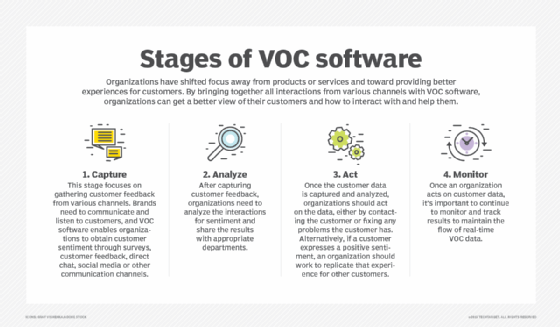Why businesses need voice of the customer analytics (original) (raw)
Article 3 of 4
Part of: Understanding voice of the customer as a key component to success
With multiple methodologies for gathering customer feedback, it is more important than ever to analyze and create action plans based on voice of the customer analytics.
A key tenet of customer success is to help customers attain measurable value from using a company's products and services. It is driven by listening to customers and identifying and solving challenges through voice of the customer analytics.
It is not enough to ask customers questions about their experiences. It is essential to take their feedback, glean insights from it and then put those insights into action to improve their experience.
Why businesses need voice of the customer analytics
It is not enough for an organization to solicit customer feedback. To create customer loyalty, an organization must analyze that feedback and make changes accordingly. Voice of the customer (VoC) programs can help businesses improve their services by identifying common customer pain points, providing direction on what should change as well as shed insight into where the experience is already working for the customers. Ultimately, being able to appropriately act on feedback gathered by voice of the customer analytics helps separate market leaders from their competitors.
Gathering data for voice of the customer analytics
A successful VoC program involves much more than sending out surveys or reviewing posts on social media. It is essential to determine what type of information is needed across the end-to-end customer journey -- acquisition, onboarding and retention. Using these touchpoints provides guidance on identifying what and where the knowledge gaps are, as well as if the collected feedback is actionable.

A successful VoC program consists of four stages: capture, analyze, act, monitor.
Valuable feedback is dependent on asking questions that prompt meaningful and honest responses. To that end, organizations must be prepared to hear the positive and negative experiences. This feedback allows organizations to reinforce what is working well and should be continued or expanded upon versus what is lacking or needs improvement.
Valuable feedback is dependent on asking questions that prompt meaningful and honest responses.
Organizations gather data from many platforms and areas of the business for voice of the customer analytics. For example, an organization can gather data related to:
- The customer journey, or customer lifecycle, such as:
- Collecting data tied to customer pain points in doing business with the organization.
- Identifying gaps in the current experiences -- or a gap analysis -- to understand where the product, service or experience misses the mark with a customer, as well uncover new opportunities in the experience.
- Closing the loop with customers by reaching back out to them to ensure that their issues have been resolved or get additional information to help them reach a resolution.
- Customer segmentation used to understand what types or categories of customers make up the sales of a product or service, as well as which of them are most to least engaged.
- Tracking customer trends to understand how they are buying, using or moving from one product or service to another for differentiated features, functionality, pricing, etc.
- Determining if a product or service, existing or new, will solve an existing problem, or how products and services can be innovated upon to improve the experience.
Direct, indirect and inferred feedback
Customer feedback for VoC programs falls into one of three feedback categories:
Direct feedback
This type of feedback provides insight into how customers perceive products and/or services via communication targeted at the organization. In B2B markets, examples include customer relationship surveys, touchpoints and transactional surveys. B2C direct feedback examples include post-purchase surveys and opinion forms about products, services or experiences. Across both B2B and B2C, additional direct feedback types are testimonials and customer support interactions.
Indirect feedback
Indirect feedback occurs when customers take to social media or a review forum to talk about the organization's products or services.
Inferred feedback
Inferred feedback is often data that has been collected about customers from the CRM software on their interaction with the organization. It can guide ongoing interactions, such as future marketing campaigns and promotional activities, as well as provide insight into customer intent via contact center data, purchase behavior, text analytics and website traffic. This type of data does not require the customers to actively provide feedback.
How to strategically use VoC data
A successful VoC program starts by capturing customer insights for use across an organization. By analyzing those insights, an organization can develop a plan of action to address any positive and/or negative feedback. Here are some ways an organization can use its VoC data:
- Customer experience: Organizations will be able to understand their customers' overall level of satisfaction (CSAT), their general perception of the brand (Net Promoter Score/NPS), the customer effort score (CES) and performance (attributes) across different steps of the customer journey. This feedback helps identify what features of the product or services need to be addressed. CX teams can even co-create action plans with cross-functional teams to improve the experience.
- Product development: VoC data from existing products -- such as product performance, price sensitivity, quality, UI and UX -- acts as guidance while developing new products. Product usage and experience statistics can give insights on which features need upgrades and which require further development.
- Brand management: A brand is only as good as its perceived reputation -- online and off. A company's reputation is essential, as customers use online research to get insight into products or services. Shoppers want the reassurance that they are making the right choice and will review the feedback provided by other customers to aid in their decision-making process. As such, VoC data can monitor customer satisfaction, retention and loyalty, and then use that data to identify improvement opportunities.
- Marketing strategy: VoC data can help guide the marketing team around how best to ensure that customers are kept apprised of new products or services, as well as new features or improvements for existing products or services. The team also uses competitive research and intelligence to understand the future of the market and provide insight on what may impact existing products or services. They can then incorporate those findings into a marketing strategy to guide future promotional content.
Improving CX with voice of the customer analytics
As the organization develops a VoC program and the questions to ask the customer, consider possible responses and what steps the organization will take to address any revealed issues. Listening to the customer is only the first step. True success is dependent on analyzing that feedback and incorporating it into a meaningful action plan.
Dig Deeper on Customer experience management
-
 7 customer experience trends to know in 2025
7 customer experience trends to know in 2025  By: Robin Gareiss
By: Robin Gareiss -
 What is customer experience (CX) and why is it important?
What is customer experience (CX) and why is it important?  By: Nick Barney
By: Nick Barney -
 SurveyMonkey launches Build with AI to create surveys faster
SurveyMonkey launches Build with AI to create surveys faster  By: Mary Reines
By: Mary Reines -
 What is customer experience management (CXM)? Ultimate guide
What is customer experience management (CXM)? Ultimate guide  By: Don Fluckinger
By: Don Fluckinger
Part of: Understanding voice of the customer as a key component to success
Article 3 of 4